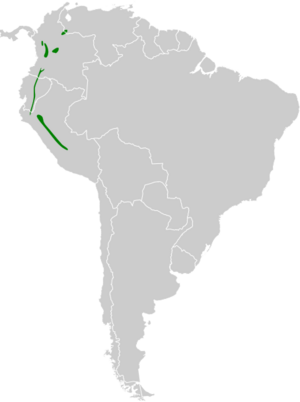White-capped tanager facts for kids
Quick facts for kids White-capped tanager |
|
|---|---|
 |
|
| Conservation status | |
| Scientific classification | |
 |
The white-capped tanager (Sericossypha albocristata) is a beautiful bird from South America. It belongs to the tanager family. This bird is special because it's the only species in its group, called the genus Sericossypha.
It's the heaviest tanager, weighing about 114 grams (4 ounces). It grows to be about 24 centimeters (9.5 inches) long. This bird is mostly shiny black. It has a big white cap on its head and a bright red throat. The red throat is brightest on adult males.
You can find white-capped tanagers in countries like Colombia, Venezuela, Ecuador, and Peru. They live high up in the mountains, usually between 1600 and 3200 meters (about 5200 to 10500 feet) above sea level.
Contents
Where White-Capped Tanagers Live
These birds prefer humid Andean forests. They often live in groups of up to 20 birds. These groups stay close together. They fly from tree to tree, looking for food as a team.
What White-Capped Tanagers Eat
White-capped tanagers enjoy a varied diet. They eat fruits and seeds. They also like to snack on insects. Some of their favorite insects include wasps and bees and beetles.
About the White-Capped Tanager's Name
The white-capped tanager was first officially described in 1843. A French bird expert named Frédéric de Lafresnaye gave it the Latin name Tanagra (Lamprotes) albo-cristatus.
Later, in 1844, another expert named René Lesson created the special group Sericossypha just for this bird. The name Sericossypha comes from two old Greek words. Sērikos means "silken," and kossuphos means "blackbird."
The second part of its name, albocristata, is from Latin. Albus means "white," and cristatus means "crested" or "plumed." So, its full scientific name describes its silky black feathers and white crest! This bird is unique because there are no different types or subspecies of it.
See Also
- Magpie tanager – Learn about another interesting bird in the tanager family.


